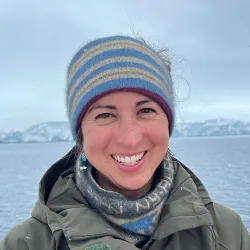Alia Khan
Research Affiliate
About Alia
Alia Khan is an Associate Professor in the Department of Environmental Sciences at Western Washington University. She has been working in polar and high mountain regions for over a decade to quantify the impacts of black carbon and other light absorbing particles on the surface albedo of the cryosphere. She combines environmental chemistry and optical remote sensing (by UAV and satellite) to document snow and ice melt in mountainous and polar regions. Her research explores the impact of snow algae growth and aerosol deposition, including the resulting impacts on spectral albedo, melt, and water quality. After working as a postdoc at NSIDC on a USAID-funded project to quantify snow and ice melt in high Asia, she moved to Bellingham, Washington. She now leads the Western Washington Cryospheric Sciences Remote Sensing and Aquatic Biogeochemistry Lab. Khan is often looking for master of science students to join her group. Students will have the opportunity to conduct intensive summer fieldwork on the local glaciated stratovolcanoes, and potentially in the polar regions.
Specialties
Current Research
Dr. Khan is currently managing over 2.5 million dollars in federal research funding from six projects (2 NASA-funded and 4 NSF-funded) across the global cryosphere, from the Arctic to the Antarctic, and the glaciated North Cascades. She has a five-year NSF-CAREER award that utilizes the wealth of new high resolution multi-spectral satellite imagery to explore the role of coastal Antarctic snow algae and light absorbing particles on snowmelt. It also includes annual field seasons to the West Antarctic Peninsula region to develop a seasonal time-series to ground validate our mapping algorithms. This research has demonstrated that snow algae blooms can be mapped by UAV and from space and that snow algae can contribute substantially to albedo change, resulting in snow melt advancement. This is of concern because warming temperatures will likely further stimulate snow algae blooms in high alpine and high latitude environments. She is also the Lead-PI on a NSF-EAGER award that utilizes data from multi and hyperspectral imagers to map spectral properties of sea ice, while also funding and advising engineering students in the Colorado Space Grant Consortium who are helping to develop a robotic system to retrieve snow samples with a UAV. Also, she is leading a NSF-RAPID award to quantify the impacts of increased smoke deposition on the Greenland Ice Sheet, due to an increase in high-latitude wildfires. The two NASA awards are also focused on quantifying the impacts light absorbing particles on albedo and snowmelt in the global cryosphere. The first NASA-award is to quantify the impact of smoke-derived black carbon upon sea ice in the changing Arctic climate. The second is to evaluate commercial SmallSat data for detection and mapping of snow algae (described more below). Sources of support: NSF and NASA
Commercial Sensor Evaluation for Detection and Mapping of Snow Algae: Snow algae are common in alpine snowpacks in the global cryosphere. The team’s recent research shows that snow algae are drivers of snowmelt due to their absorption of solar radiation in the visible wavelengths, which leads to a significant reduction in snow albedo. However, snow algae are ephemeral and often occur in small patches. This research evaluates high resolution commercial satellite data (CSD) for detection and mapping of snow algae through comparison of in situ snow samples collected for laboratory analysis. Research uses the Pacific Northwest cryosphere to develop novel algorithms based on in situ snow sample collection. An additional objective is to evaluate CSD products for their utility in snow algae detection and mapping. After collecting snow samples from the field, the team analyzes them in the lab and uses the data to validate satellite-derived maps of colored snow algae from space. Source of support: NASA
Education
